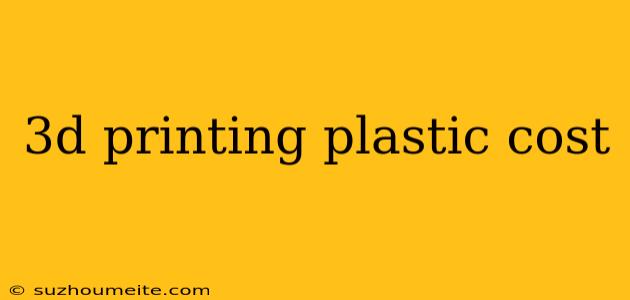3D Printing Plastic Cost: Understanding the Expenses Involved
As 3D printing technology continues to evolve, the cost of 3D printing plastic has become a crucial factor for individuals, businesses, and industries alike. The cost of 3D printing plastic can vary greatly, depending on several factors such as the type of plastic, the quantity needed, and the intended application. In this article, we will delve into the expenses involved in 3D printing plastic, exploring the factors that affect the cost and providing an overview of the current market prices.
Types of 3D Printing Plastics and Their Costs
There are several types of 3D printing plastics, each with its own unique characteristics, advantages, and costs. Here are some of the most common types of 3D printing plastics and their approximate costs:
PLA (Polylactic Acid)
- Cost: $20-$50 per kilogram
- Characteristics: Biodegradable, renewable, and compostable
- Applications: Prototyping, model making, and consumer products
ABS (Acrylonitrile Butadiene Styrene)
- Cost: $30-$70 per kilogram
- Characteristics: Impact-resistant, heat-resistant, and durable
- Applications: Automotive, aerospace, and industrial applications
PETG (Polyethylene Terephthalate Glycol)
- Cost: $40-$80 per kilogram
- Characteristics: Chemical-resistant, flexible, and food-safe
- Applications: Consumer products, medical devices, and industrial equipment
Nylon
- Cost: $50-$100 per kilogram
- Characteristics: Strong, flexible, and resistant to abrasion and impact
- Applications: Industrial, automotive, and aerospace applications
Ultem
- Cost: $100-$200 per kilogram
- Characteristics: High-temperature resistance, chemical resistance, and high strength
- Applications: Aerospace, industrial, and medical devices
Factors Affecting 3D Printing Plastic Cost
Several factors can influence the cost of 3D printing plastic, including:
Material Quality
- High-quality materials with precise specifications can be more expensive than lower-quality materials.
Quantity
- Buying in bulk can reduce the cost per kilogram of 3D printing plastic.
Color and Additives
- Custom colors and additives can increase the cost of 3D printing plastic.
Branding and Certification
- Branded materials from reputable manufacturers may be more expensive than generic or unbranded materials.
Local Taxes and Tariffs
- Local taxes and tariffs can affect the final cost of 3D printing plastic.
Conclusion
The cost of 3D printing plastic can vary greatly depending on the type of plastic, quantity, and intended application. Understanding the factors that affect the cost of 3D printing plastic can help individuals and businesses make informed decisions when selecting materials for their projects. By considering the characteristics, advantages, and costs of different 3D printing plastics, users can optimize their designs and reduce costs without compromising on quality.
